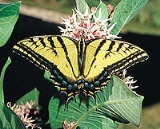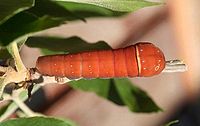
Two-tailed Swallowtail
Encyclopedia
The Two-tailed Swallowtail (Papilio multicaudata) is a species of the Papilionidae family found in western North America
from British Columbia
to Central America
.
, Western, and Eastern Tiger Swallowtail
s, but has thinner and fewer black stripes on the wings and the hind wing has two tails. The Two-tailed Swallowtail has distinctive yellow wings with a black tiger striping. Each hindwing has several blue markings (top and bottom). The eyespots can fool predators into attacking the rear of the butterfly instead of the head, giving the butterfly a chance to escape.
The wingspan of this particular species is 68 to 104 mm (2.7 to 4.1 in) making it the largest swallowtail in western North America.
 The butterfly can be seen from Guatemala
The butterfly can be seen from Guatemala
, through Mexico
, the western United States to southern Canada in southern British Columbia, Alberta
and southwestern Saskatchewan
. It typically lives near streams and in moist valleys but also in canyons and cities at lower elevations lower elevations.
Host plants include: chokecherry, bitter cherry, Arizona rosewood, single-leaf ash, hoptree, and Arizona Sycamore.
Larvae feed on chokeberry
, willow (Salix spp.), cherry (Prunus
spp.), poplar (Populus spp.), and ash (Fraxinus spp.).
The Two-tailed Swallowtail is the state butterfly of Arizona
.
North America
North America is a continent wholly within the Northern Hemisphere and almost wholly within the Western Hemisphere. It is also considered a northern subcontinent of the Americas...
from British Columbia
British Columbia
British Columbia is the westernmost of Canada's provinces and is known for its natural beauty, as reflected in its Latin motto, Splendor sine occasu . Its name was chosen by Queen Victoria in 1858...
to Central America
Central America
Central America is the central geographic region of the Americas. It is the southernmost, isthmian portion of the North American continent, which connects with South America on the southeast. When considered part of the unified continental model, it is considered a subcontinent...
.
Description
Its appearance is similar to the Giant SwallowtailGiant Swallowtail
The Giant Swallowtail is a swallowtail butterfly common in various parts of North America and marginally into South America . In the United States and Canada it is mainly found in the south and east. With a wingspan of about , it is the largest butterfly in Canada and the United States.-Adult:An...
, Western, and Eastern Tiger Swallowtail
Eastern tiger swallowtail
The Eastern Tiger Swallowtail is a species of swallowtail butterfly native to North America. It is one of the most familiar butterflies in the eastern United States, where it is common in many different habitats. It flies from spring to fall, during which it produces two to three broods...
s, but has thinner and fewer black stripes on the wings and the hind wing has two tails. The Two-tailed Swallowtail has distinctive yellow wings with a black tiger striping. Each hindwing has several blue markings (top and bottom). The eyespots can fool predators into attacking the rear of the butterfly instead of the head, giving the butterfly a chance to escape.
The wingspan of this particular species is 68 to 104 mm (2.7 to 4.1 in) making it the largest swallowtail in western North America.

Guatemala
Guatemala is a country in Central America bordered by Mexico to the north and west, the Pacific Ocean to the southwest, Belize to the northeast, the Caribbean to the east, and Honduras and El Salvador to the southeast...
, through Mexico
Mexico
The United Mexican States , commonly known as Mexico , is a federal constitutional republic in North America. It is bordered on the north by the United States; on the south and west by the Pacific Ocean; on the southeast by Guatemala, Belize, and the Caribbean Sea; and on the east by the Gulf of...
, the western United States to southern Canada in southern British Columbia, Alberta
Alberta
Alberta is a province of Canada. It had an estimated population of 3.7 million in 2010 making it the most populous of Canada's three prairie provinces...
and southwestern Saskatchewan
Saskatchewan
Saskatchewan is a prairie province in Canada, which has an area of . Saskatchewan is bordered on the west by Alberta, on the north by the Northwest Territories, on the east by Manitoba, and on the south by the U.S. states of Montana and North Dakota....
. It typically lives near streams and in moist valleys but also in canyons and cities at lower elevations lower elevations.
Host plants include: chokecherry, bitter cherry, Arizona rosewood, single-leaf ash, hoptree, and Arizona Sycamore.
Larvae feed on chokeberry
Chokeberry
Aronia, the chokeberries, are two to three species of deciduous shrubs in the family Rosaceae, native to eastern North America. They are most commonly found in wet woods and swamps. Chokeberries are cultivated as ornamental plants and also because they are very high in antioxidant pigment...
, willow (Salix spp.), cherry (Prunus
Prunus
Prunus is a genus of trees and shrubs, which includes the plums, cherries, peaches, apricots and almonds. There are around 430 species spread throughout the northern temperate regions of the globe. Many members of the genus are widely cultivated for fruit and ornament.-Botany:Members of the genus...
spp.), poplar (Populus spp.), and ash (Fraxinus spp.).
The Two-tailed Swallowtail is the state butterfly of Arizona
Arizona
Arizona ; is a state located in the southwestern region of the United States. It is also part of the western United States and the mountain west. The capital and largest city is Phoenix...
.
Life cycle
Adults fly during spring and summer and there is 1 brood. Females lay eggs singly on the host plant. The caterpillar will fold the host plants leaves and tie them together with silk they will then eat from this structure. The pupae will over winter then emerge in May.Subspecies
Listed alphabetically.- P. m. grandiosus Austin & Emmel, 1998
- P. m. multicaudata Kirby, 1884
- P. m. pusillus Austin & Emmel, 1998

